cruise control RENAULT SCENIC 2011 J95 / 3.G Engine And Peripherals Siemens Injection Workshop Manual
[x] Cancel search | Manufacturer: RENAULT, Model Year: 2011, Model line: SCENIC, Model: RENAULT SCENIC 2011 J95 / 3.GPages: 329, PDF Size: 1.71 MB
Page 10 of 329

13B-10
MR-372-J84-13B050$117.mif
V17
Siemens Injection
SID301 and 304
Vdiag No.: 44-45-48-49-4D-4C
Program No.: B1 and B2DIESEL INJECTION
Fault finding – List and location of components13B
Heating elements:
The heating elements are located in the cooling circuit before the additional coolant pump which cools the
turbocharger (Vdiag 45, 49 and 4D only).
Coolant temperature sensor:
The sensor is located on the cylinder head near the engine water chamber.
Air temperature sensor:
The air temperature sensor is located at the air circuit inlet, integrated into the air flowmeter.
Turbocharging pressure sensor solenoid valve:
The solenoid valve is located on the turbocharger.
Catalytic converter:
The catalytic converter is located upstream of the exhaust system and downstream of the turbocharger.
Fuel temperature sensor:
The sensor is located near the injection pump and injector return.
Catalytic converter downstream temperature sensor:
The sensor is located after the catalytic converter.
Turbine upstream temperature sensor:
This sensor is located between the exhaust pipe and the turbocharger.
Cruise control/speed limiter on/off switch:
This switch is located in the passenger compartment to the left of the steering wheel near the lighting dimmer.
Water in diesel fuel sensor (optional):
This sensor is located in the diesel filter.
Fan unit relay:
The relay is located on the cooling radiator.
Accelerator potentiometer:
The potentiometer is located on the accelerator pedal.
Brake pedal switch:
The switch is located on the brake pedal.
Clutch pedal switch:
The switch is located on the clutch pedal.
Heater plugs:
The heater plugs are located on the cylinder head.
Particle filter injector:
The injector is located between the particle filter injector fuel pump and the exhaust pipe. (Vdiag 45, 49 and 4D only)
Electric fuel pump:
The pump is located between the tank and the particle filter injector fuel filter. (Vdiag 45, 49 and 4D only)
Page 17 of 329
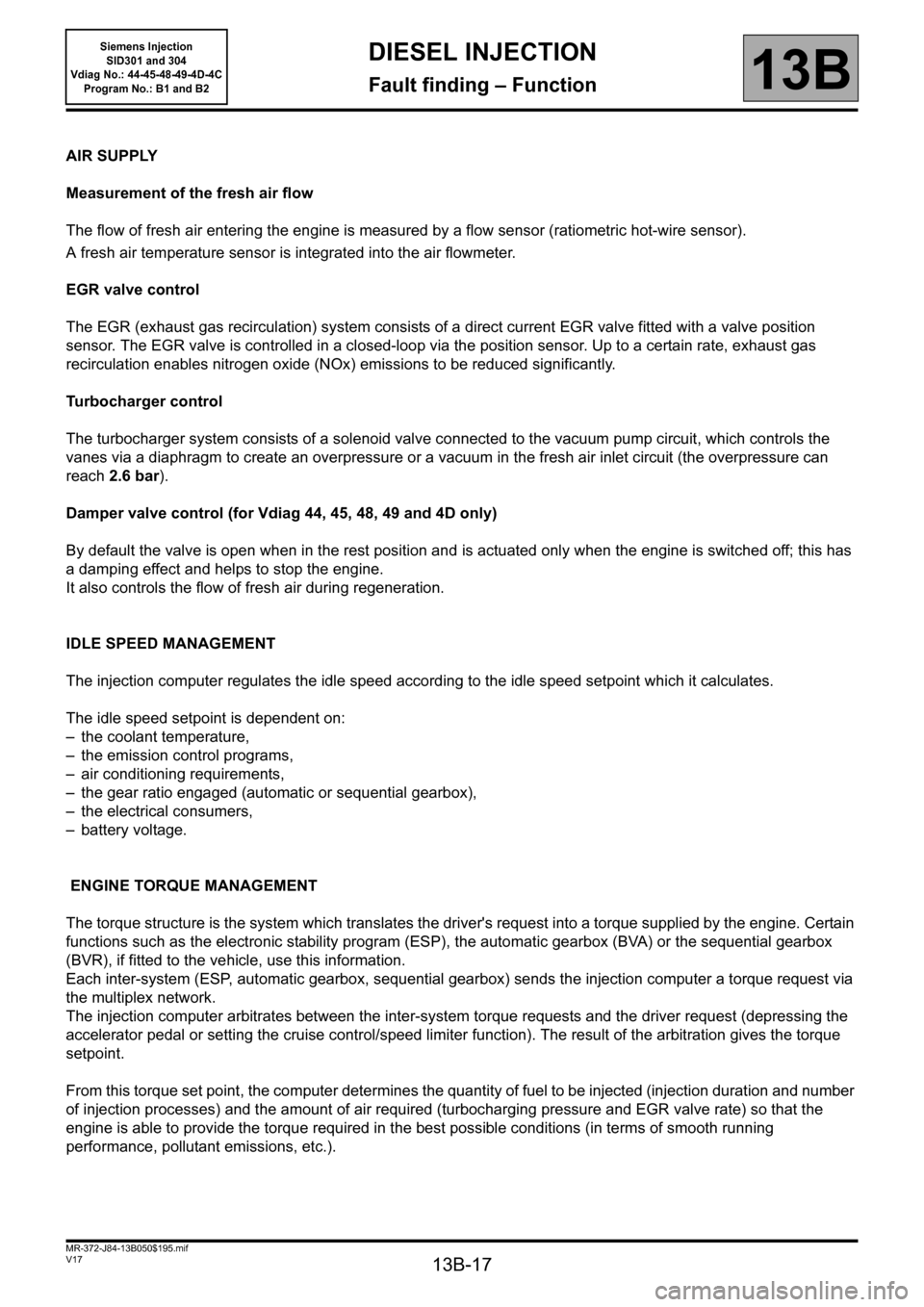
13B-17
MR-372-J84-13B050$195.mif
V17
Siemens Injection
SID301 and 304
Vdiag No.: 44-45-48-49-4D-4C
Program No.: B1 and B2DIESEL INJECTION
Fault finding – Function13B
AIR SUPPLY
Measurement of the fresh air flow
The flow of fresh air entering the engine is measured by a flow sensor (ratiometric hot-wire sensor).
A fresh air temperature sensor is integrated into the air flowmeter.
EGR valve control
The EGR (exhaust gas recirculation) system consists of a direct current EGR valve fitted with a valve position
sensor. The EGR valve is controlled in a closed-loop via the position sensor. Up to a certain rate, exhaust gas
recirculation enables nitrogen oxide (NOx) emissions to be reduced significantly.
Turbocharger control
The turbocharger system consists of a solenoid valve connected to the vacuum pump circuit, which controls the
vanes via a diaphragm to create an overpressure or a vacuum in the fresh air inlet circuit (the overpressure can
reach 2.6 bar).
Damper valve control (for Vdiag 44, 45, 48, 49 and 4D only)
By default the valve is open when in the rest position and is actuated only when the engine is switched off; this has
a damping effect and helps to stop the engine.
It also controls the flow of fresh air during regeneration.
IDLE SPEED MANAGEMENT
The injection computer regulates the idle speed according to the idle speed setpoint which it calculates.
The idle speed setpoint is dependent on:
– the coolant temperature,
– the emission control programs,
– air conditioning requirements,
– the gear ratio engaged (automatic or sequential gearbox),
– the electrical consumers,
– battery voltage.
ENGINE TORQUE MANAGEMENT
The torque structure is the system which translates the driver's request into a torque supplied by the engine. Certain
functions such as the electronic stability program (ESP), the automatic gearbox (BVA) or the sequential gearbox
(BVR), if fitted to the vehicle, use this information.
Each inter-system (ESP, automatic gearbox, sequential gearbox) sends the injection computer a torque request via
the multiplex network.
The injection computer arbitrates between the inter-system torque requests and the driver request (depressing the
accelerator pedal or setting the cruise control/speed limiter function). The result of the arbitration gives the torque
setpoint.
From this torque set point, the computer determines the quantity of fuel to be injected (injection duration and number
of injection processes) and the amount of air required (turbocharging pressure and EGR valve rate) so that the
engine is able to provide the torque required in the best possible conditions (in terms of smooth running
performance, pollutant emissions, etc.).
Page 18 of 329
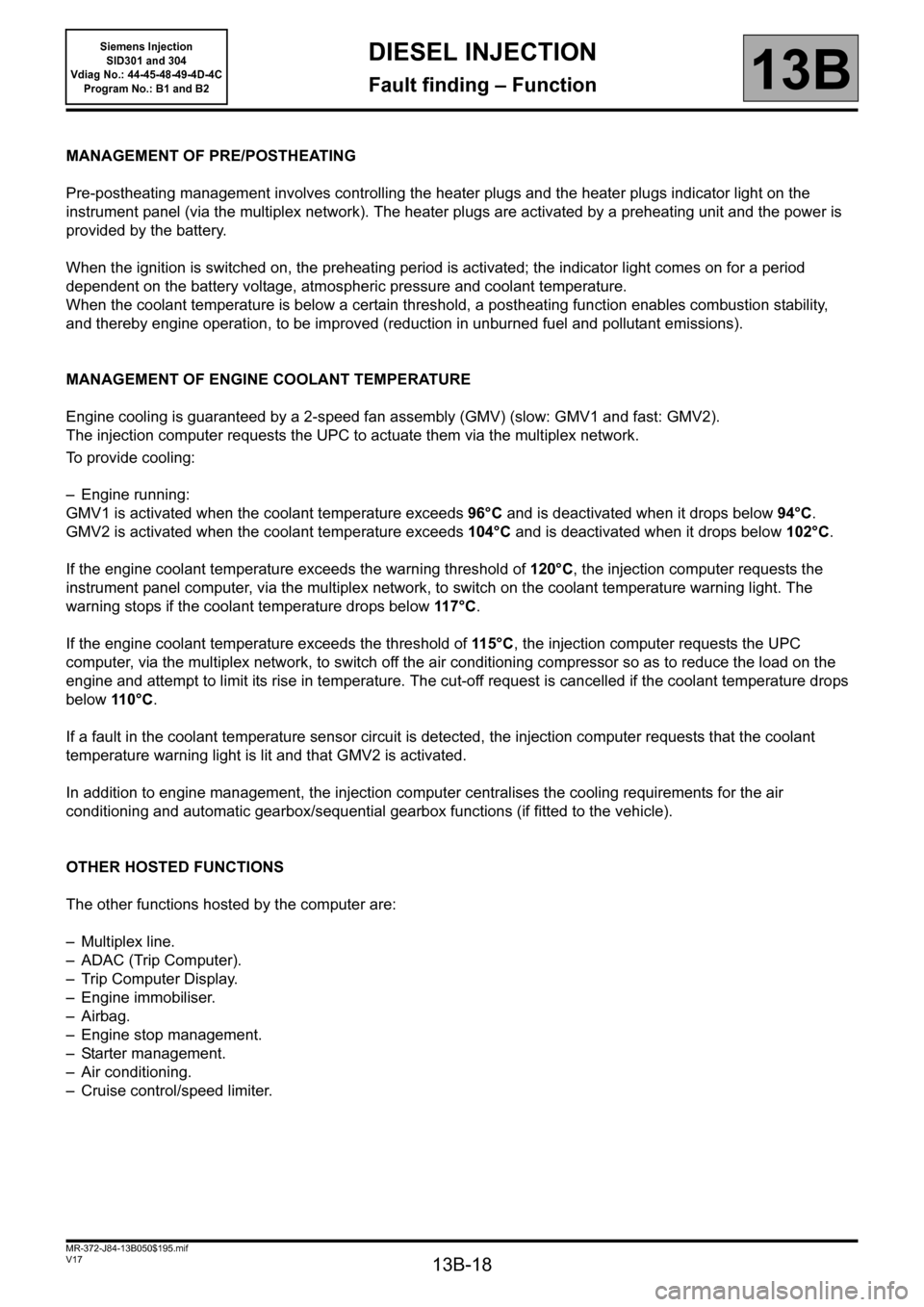
13B-18
MR-372-J84-13B050$195.mif
V17
Siemens Injection
SID301 and 304
Vdiag No.: 44-45-48-49-4D-4C
Program No.: B1 and B2DIESEL INJECTION
Fault finding – Function13B
MANAGEMENT OF PRE/POSTHEATING
Pre-postheating management involves controlling the heater plugs and the heater plugs indicator light on the
instrument panel (via the multiplex network). The heater plugs are activated by a preheating unit and the power is
provided by the battery.
When the ignition is switched on, the preheating period is activated; the indicator light comes on for a period
dependent on the battery voltage, atmospheric pressure and coolant temperature.
When the coolant temperature is below a certain threshold, a postheating function enables combustion stability,
and thereby engine operation, to be improved (reduction in unburned fuel and pollutant emissions).
MANAGEMENT OF ENGINE COOLANT TEMPERATURE
Engine cooling is guaranteed by a 2-speed fan assembly (GMV) (slow: GMV1 and fast: GMV2).
The injection computer requests the UPC to actuate them via the multiplex network.
To provide cooling:
– Engine running:
GMV1 is activated when the coolant temperature exceeds 96°C and is deactivated when it drops below 94°C.
GMV2 is activated when the coolant temperature exceeds 104°C and is deactivated when it drops below 102°C.
If the engine coolant temperature exceeds the warning threshold of 120°C, the injection computer requests the
instrument panel computer, via the multiplex network, to switch on the coolant temperature warning light. The
warning stops if the coolant temperature drops below 117 ° C.
If the engine coolant temperature exceeds the threshold of 11 5 ° C, the injection computer requests the UPC
computer, via the multiplex network, to switch off the air conditioning compressor so as to reduce the load on the
engine and attempt to limit its rise in temperature. The cut-off request is cancelled if the coolant temperature drops
below 110°C.
If a fault in the coolant temperature sensor circuit is detected, the injection computer requests that the coolant
temperature warning light is lit and that GMV2 is activated.
In addition to engine management, the injection computer centralises the cooling requirements for the air
conditioning and automatic gearbox/sequential gearbox functions (if fitted to the vehicle).
OTHER HOSTED FUNCTIONS
The other functions hosted by the computer are:
– Multiplex line.
– ADAC (Trip Computer).
– Trip Computer Display.
– Engine immobiliser.
– Airbag.
– Engine stop management.
– Starter management.
– Air conditioning.
– Cruise control/speed limiter.
Page 24 of 329
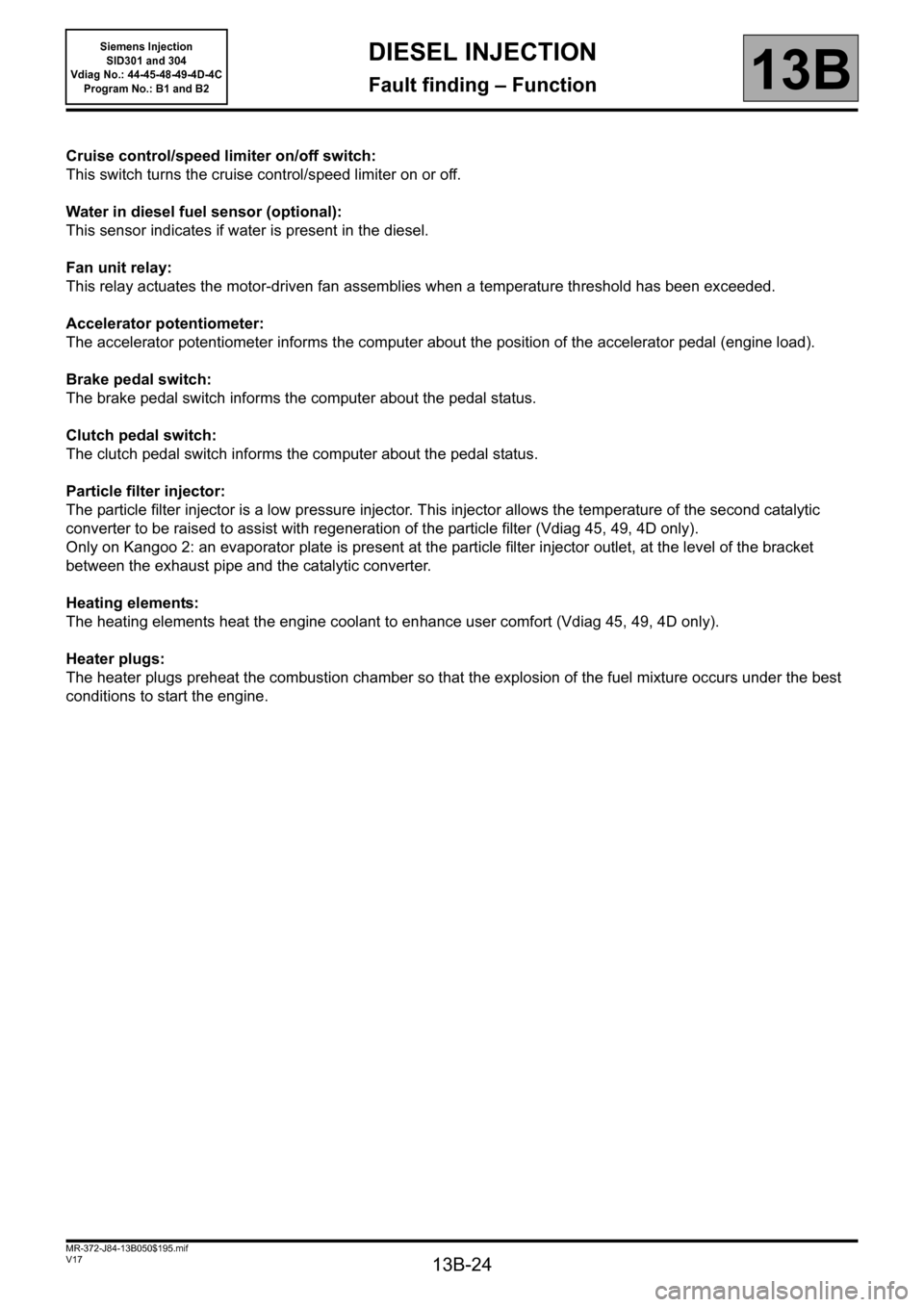
13B-24
MR-372-J84-13B050$195.mif
V17
Siemens Injection
SID301 and 304
Vdiag No.: 44-45-48-49-4D-4C
Program No.: B1 and B2DIESEL INJECTION
Fault finding – Function13B
Cruise control/speed limiter on/off switch:
This switch turns the cruise control/speed limiter on or off.
Water in diesel fuel sensor (optional):
This sensor indicates if water is present in the diesel.
Fan unit relay:
This relay actuates the motor-driven fan assemblies when a temperature threshold has been exceeded.
Accelerator potentiometer:
The accelerator potentiometer informs the computer about the position of the accelerator pedal (engine load).
Brake pedal switch:
The brake pedal switch informs the computer about the pedal status.
Clutch pedal switch:
The clutch pedal switch informs the computer about the pedal status.
Particle filter injector:
The particle filter injector is a low pressure injector. This injector allows the temperature of the second catalytic
converter to be raised to assist with regeneration of the particle filter (Vdiag 45, 49, 4D only).
Only on Kangoo 2: an evaporator plate is present at the particle filter injector outlet, at the level of the bracket
between the exhaust pipe and the catalytic converter.
Heating elements:
The heating elements heat the engine coolant to enhance user comfort (Vdiag 45, 49, 4D only).
Heater plugs:
The heater plugs preheat the combustion chamber so that the explosion of the fuel mixture occurs under the best
conditions to start the engine.
Page 26 of 329
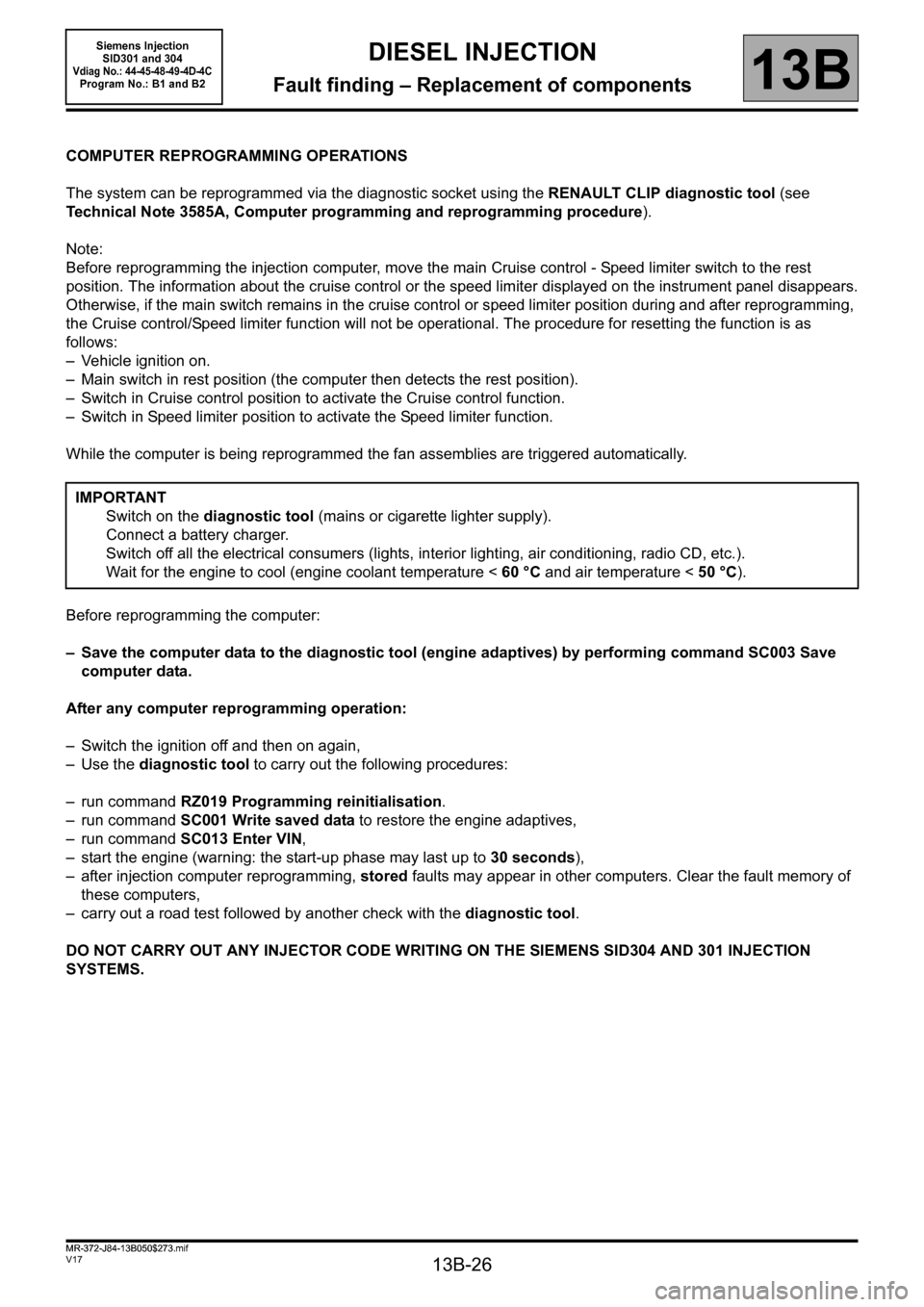
13B-26
MR-372-J84-13B050$273.mif
V17
13B
DIESEL INJECTION
Fault finding – Replacement of components
COMPUTER REPROGRAMMING OPERATIONS
The system can be reprogrammed via the diagnostic socket using the RENAULT CLIP diagnostic tool (see
Technical Note 3585A, Computer programming and reprogramming procedure).
Note:
Before reprogramming the injection computer, move the main Cruise control - Speed limiter switch to the rest
position. The information about the cruise control or the speed limiter displayed on the instrument panel disappears.
Otherwise, if the main switch remains in the cruise control or speed limiter position during and after reprogramming,
the Cruise control/Speed limiter function will not be operational. The procedure for resetting the function is as
follows:
– Vehicle ignition on.
– Main switch in rest position (the computer then detects the rest position).
– Switch in Cruise control position to activate the Cruise control function.
– Switch in Speed limiter position to activate the Speed limiter function.
While the computer is being reprogrammed the fan assemblies are triggered automatically.
Before reprogramming the computer:
– Save the computer data to the diagnostic tool (engine adaptives) by performing command SC003 Save
computer data.
After any computer reprogramming operation:
– Switch the ignition off and then on again,
–Use the diagnostic tool to carry out the following procedures:
– run command RZ019 Programming reinitialisation.
– run command SC001 Write saved data to restore the engine adaptives,
– run command SC013 Enter VIN,
– start the engine (warning: the start-up phase may last up to 30 seconds),
– after injection computer reprogramming, stored faults may appear in other computers. Clear the fault memory of
these computers,
– carry out a road test followed by another check with the diagnostic tool.
DO NOT CARRY OUT ANY INJECTOR CODE WRITING ON THE SIEMENS SID304 AND 301 INJECTION
SYSTEMS.IMPORTANT
Switch on the diagnostic tool (mains or cigarette lighter supply).
Connect a battery charger.
Switch off all the electrical consumers (lights, interior lighting, air conditioning, radio CD, etc.).
Wait for the engine to cool (engine coolant temperature < 60 °C and air temperature < 50 °C).
MR-372-J84-13B050$273.mif
Siemens Injection
SID301 and 304
Vdiag No.: 44-45-48-49-4D-4CProgram No.: B1 and B2
Page 27 of 329

13B-27
MR-372-J84-13B050$273.mif
V17
Siemens Injection
SID301 and 304
Vdiag No.: 44-45-48-49-4D-4C
Program No.: B1 and B2DIESEL INJECTION
Fault finding – Replacement of components13B
If no communication is possible with the injection computer during reprogramming or programming:
●Clear the programming using command RZ019 Reinitialise programming.
●Clear any faults using command RZ001 Fault memory.
●Enter the V.I.N. using command SC013 Enter VIN code.
●Perform a powerlatch.
●Perform a detection of the cruise control - speed limiter and the air conditioning:
– Vehicle ignition on.
– Main switch in rest position (the computer then detects the rest position).
– Switch in Cruise control position to activate the Cruise control function.
– Switch in Speed limiter position to activate the Speed limiter function.
– Air conditioning in the ON position.
●For Kangoo II, program the values for fast idle speed (if equipped) and vehicle speed restriction (if equipped)
using commands SC041 Modification of commercial vehicle idle speed and SC040 Speed limiter.
●For Vdiag 45, 49 and 4D, carry out a particle filter regeneration using command SC017 Particle filter
regeneration (see Interpretation of commands).
●For Clio III, Modus, Megane II and Scenic II vehicles:
– If the configuration reading LC106 O.C.S. is" WITH" (check in the instrument panel computer), perform
an engine oil change and initialise the value of the oil service interval using the instrument panel.
●For Kangoo II:
– Change the engine oil and initialise the value of the oil change interval using the instrument panel.
IMPORTANT
The injection computer retains the immobiliser code for life.
The system has no security code.
It is forbidden to perform tests with computers borrowed from the Parts Department or from another vehicle
which must then be returned.
These computers are hard-coded.
If the injection computer is faulty, contact the Techline (and refer to the fault finding log).
Page 30 of 329
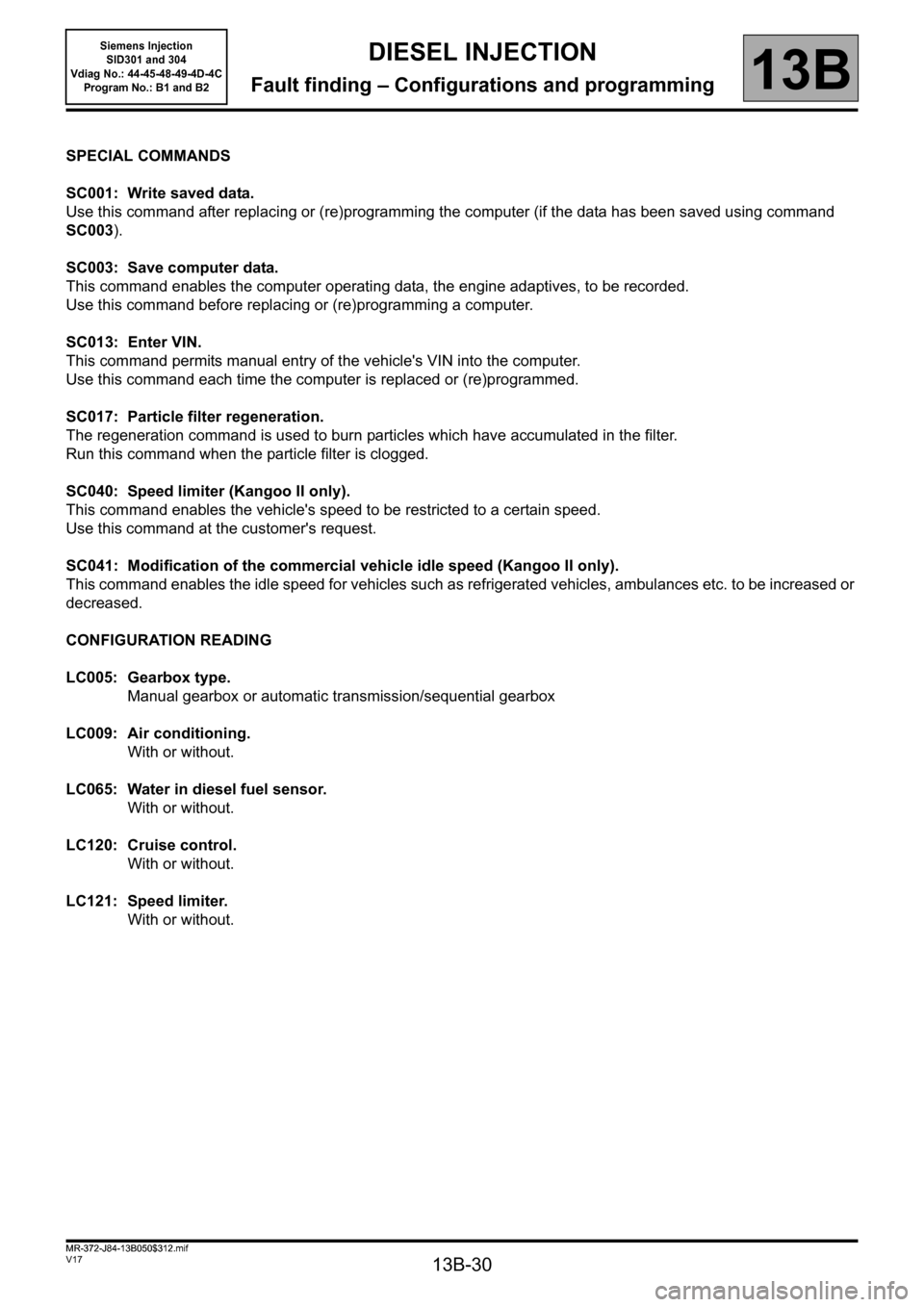
13B-30
MR-372-J84-13B050$312.mif
V17
13B
DIESEL INJECTION
Fault finding – Configurations and programming
SPECIAL COMMANDS
SC001: Write saved data.
Use this command after replacing or (re)programming the computer (if the data has been saved using command
SC003).
SC003: Save computer data.
This command enables the computer operating data, the engine adaptives, to be recorded.
Use this command before replacing or (re)programming a computer.
SC013: Enter VIN.
This command permits manual entry of the vehicle's VIN into the computer.
Use this command each time the computer is replaced or (re)programmed.
SC017: Particle filter regeneration.
The regeneration command is used to burn particles which have accumulated in the filter.
Run this command when the particle filter is clogged.
SC040: Speed limiter (Kangoo II only).
This command enables the vehicle's speed to be restricted to a certain speed.
Use this command at the customer's request.
SC041: Modification of the commercial vehicle idle speed (Kangoo II only).
This command enables the idle speed for vehicles such as refrigerated vehicles, ambulances etc. to be increased or
decreased.
CONFIGURATION READING
LC005: Gearbox type.
Manual gearbox or automatic transmission/sequential gearbox
LC009: Air conditioning.
With or without.
LC065: Water in diesel fuel sensor.
With or without.
LC120: Cruise control.
With or without.
LC121: Speed limiter.
With or without.
MR-372-J84-13B050$312.mif
Siemens Injection
SID301 and 304
Vdiag No.: 44-45-48-49-4D-4C
Program No.: B1 and B2
Page 32 of 329
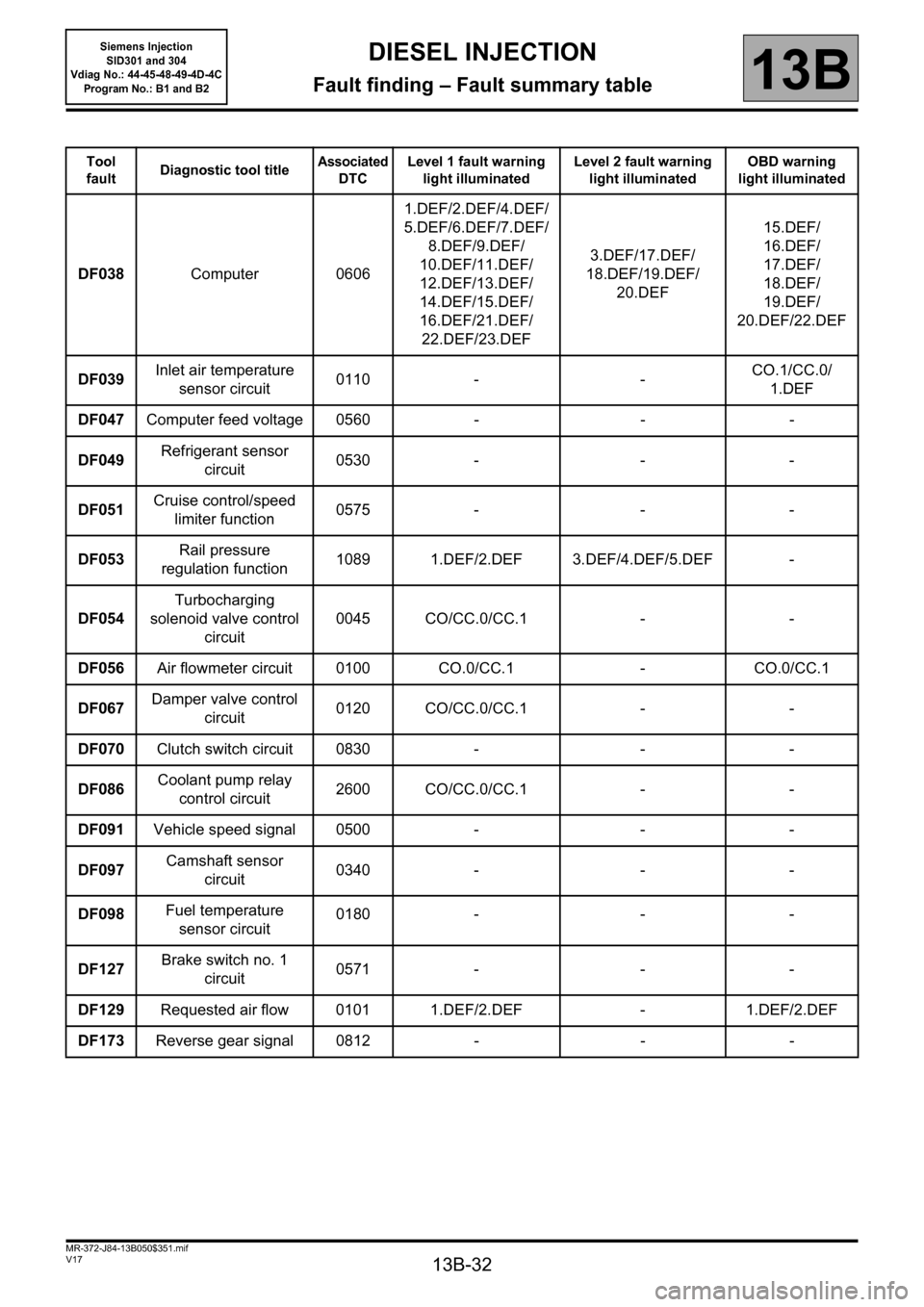
13B-32
MR-372-J84-13B050$351.mif
V17
Siemens Injection
SID301 and 304
Vdiag No.: 44-45-48-49-4D-4C
Program No.: B1 and B2DIESEL INJECTION
Fault finding – Fault summary table13B
Tool
faultDiagnostic tool titleAssociated
DTCLevel 1 fault warning
light illuminatedLevel 2 fault warning
light illuminatedOBD warning
light illuminated
DF038Computer 06061.DEF/2.DEF/4.DEF/
5.DEF/6.DEF/7.DEF/
8.DEF/9.DEF/
10.DEF/11.DEF/
12.DEF/13.DEF/
14.DEF/15.DEF/
16.DEF/21.DEF/
22.DEF/23.DEF3.DEF/17.DEF/
18.DEF/19.DEF/
20.DEF15.DEF/
16.DEF/
17.DEF/
18.DEF/
19.DEF/
20.DEF/22.DEF
DF039Inlet air temperature
sensor circuit0110 - -CO.1/CC.0/
1.DEF
DF047Computer feed voltage 0560 - - -
DF049Refrigerant sensor
circuit0530 - - -
DF051Cruise control/speed
limiter function0575 - - -
DF053Rail pressure
regulation function1089 1.DEF/2.DEF 3.DEF/4.DEF/5.DEF -
DF054Turbocharging
solenoid valve control
circuit0045 CO/CC.0/CC.1 - -
DF056Air flowmeter circuit 0100 CO.0/CC.1 - CO.0/CC.1
DF067Damper valve control
circuit0120 CO/CC.0/CC.1 - -
DF070Clutch switch circuit 0830 - - -
DF086Coolant pump relay
control circuit2600 CO/CC.0/CC.1 - -
DF091Vehicle speed signal 0500 - - -
DF097Camshaft sensor
circuit0340 - - -
DF098Fuel temperature
sensor circuit0180 - - -
DF127Brake switch no. 1
circuit0571 - - -
DF129Requested air flow 0101 1.DEF/2.DEF - 1.DEF/2.DEF
DF173Reverse gear signal 0812 - - -
Page 43 of 329
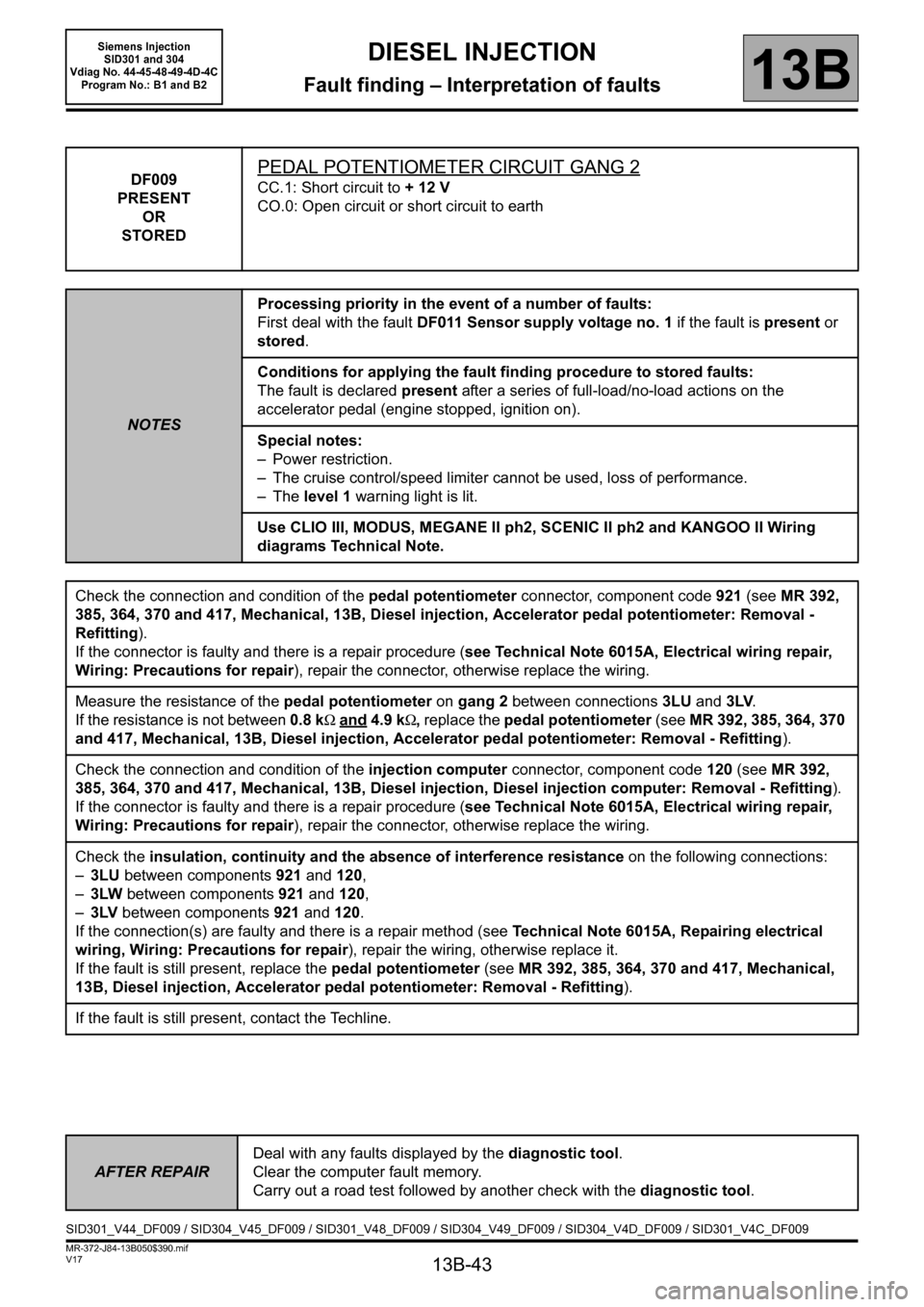
13B-43
MR-372-J84-13B050$390.mif
V17
DIESEL INJECTION
Fault finding – Interpretation of faults
Siemens Injection
SID301 and 304
Vdiag No. 44-45-48-49-4D-4C
Program No.: B1 and B2
13B
DF009
PRESENT
OR
STOREDPEDAL POTENTIOMETER CIRCUIT GANG 2
CC.1: Short circuit to + 12 V
CO.0: Open circuit or short circuit to earth
NOTESProcessing priority in the event of a number of faults:
First deal with the fault DF011 Sensor supply voltage no. 1 if the fault is present or
stored.
Conditions for applying the fault finding procedure to stored faults:
The fault is declared present after a series of full-load/no-load actions on the
accelerator pedal (engine stopped, ignition on).
Special notes:
– Power restriction.
– The cruise control/speed limiter cannot be used, loss of performance.
–The level 1 warning light is lit.
Use CLIO III, MODUS, MEGANE II ph2, SCENIC II ph2 and KANGOO II Wiring
diagrams Technical Note.
Check the connection and condition of the pedal potentiometer connector, component code921 (see MR 392,
385, 364, 370 and 417, Mechanical, 13B, Diesel injection, Accelerator pedal potentiometer: Removal -
Refitting).
If the connector is faulty and there is a repair procedure (see Technical Note 6015A, Electrical wiring repair,
Wiring: Precautions for repair), repair the connector, otherwise replace the wiring.
Measure the resistance of the pedal potentiometer on gang 2 between connections 3LU and 3LV.
If the resistance is not between 0.8 kΩ and
4.9 kΩ, replace the pedal potentiometer (see MR 392, 385, 364, 370
and 417, Mechanical, 13B, Diesel injection, Accelerator pedal potentiometer: Removal - Refitting).
Check the connection and condition of the injection computer connector, component code 120 (see MR 392,
385, 364, 370 and 417, Mechanical, 13B, Diesel injection, Diesel injection computer: Removal - Refitting).
If the connector is faulty and there is a repair procedure (see Technical Note 6015A, Electrical wiring repair,
Wiring: Precautions for repair), repair the connector, otherwise replace the wiring.
Check the insulation, continuity and the absence of interference resistance on the following connections:
–3LU between components921 and 120,
–3LW between components 921 and 120,
–3LV between components 921 and 120.
If the connection(s) are faulty and there is a repair method (see Technical Note 6015A, Repairing electrical
wiring, Wiring: Precautions for repair), repair the wiring, otherwise replace it.
If the fault is still present, replace the pedal potentiometer (see MR 392, 385, 364, 370 and 417, Mechanical,
13B, Diesel injection, Accelerator pedal potentiometer: Removal - Refitting).
If the fault is still present, contact the Techline.
AFTER REPAIRDeal with any faults displayed by the diagnostic tool.
Clear the computer fault memory.
Carry out a road test followed by another check with the diagnostic tool.
SID301_V44_DF009 / SID304_V45_DF009 / SID301_V48_DF009 / SID304_V49_DF009 / SID304_V4D_DF009 / SID301_V4C_DF009
Page 44 of 329
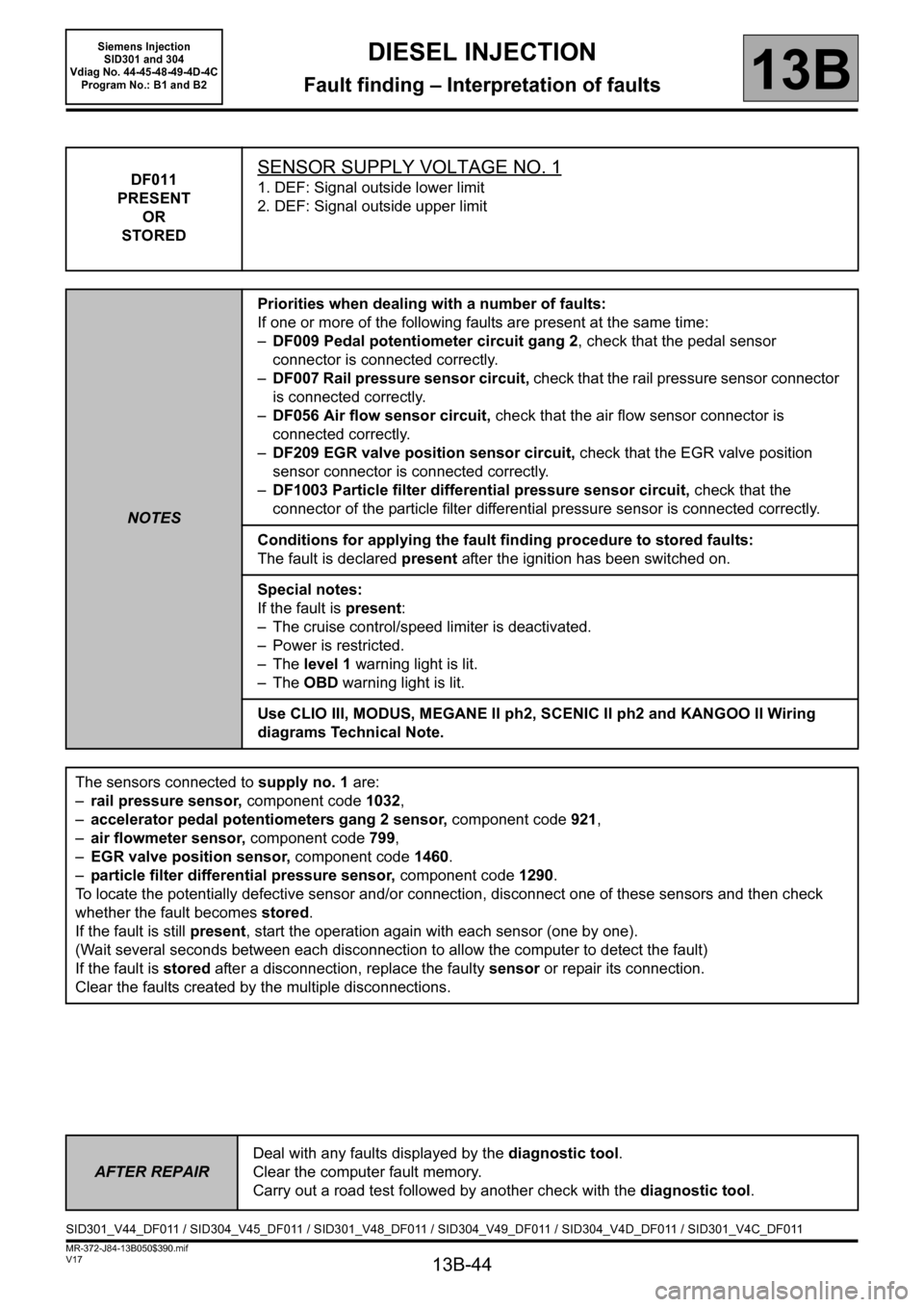
13B-44
MR-372-J84-13B050$390.mif
V17
DIESEL INJECTION
Fault finding – Interpretation of faults
Siemens Injection
SID301 and 304
Vdiag No. 44-45-48-49-4D-4C
Program No.: B1 and B2
13B
DF011
PRESENT
OR
STOREDSENSOR SUPPLY VOLTAGE NO. 1
1. DEF: Signal outside lower limit
2. DEF: Signal outside upper limit
NOTESPriorities when dealing with a number of faults:
If one or more of the following faults are present at the same time:
–DF009 Pedal potentiometer circuit gang 2, check that the pedal sensor
connector is connected correctly.
–DF007 Rail pressure sensor circuit, check that the rail pressure sensor connector
is connected correctly.
–DF056 Air flow sensor circuit, check that the air flow sensor connector is
connected correctly.
–DF209 EGR valve position sensor circuit, check that the EGR valve position
sensor connector is connected correctly.
–DF1003 Particle filter differential pressure sensor circuit, check that the
connector of the particle filter differential pressure sensor is connected correctly.
Conditions for applying the fault finding procedure to stored faults:
The fault is declared present after the ignition has been switched on.
Special notes:
If the fault is present:
– The cruise control/speed limiter is deactivated.
– Power is restricted.
–The level 1 warning light is lit.
–The OBD warning light is lit.
Use CLIO III, MODUS, MEGANE II ph2, SCENIC II ph2 and KANGOO II Wiring
diagrams Technical Note.
The sensors connected to supply no. 1 are:
–rail pressure sensor, component code1032,
–accelerator pedal potentiometers gang 2 sensor, component code921,
–air flowmeter sensor, component code799,
–EGR valve position sensor, component code 1460.
–particle filter differential pressure sensor, component code 1290.
To locate the potentially defective sensor and/or connection, disconnect one of these sensors and then check
whether the fault becomes stored.
If the fault is still present, start the operation again with each sensor (one by one).
(Wait several seconds between each disconnection to allow the computer to detect the fault)
If the fault is stored after a disconnection, replace the faulty sensor or repair its connection.
Clear the faults created by the multiple disconnections.
AFTER REPAIRDeal with any faults displayed by the diagnostic tool.
Clear the computer fault memory.
Carry out a road test followed by another check with the diagnostic tool.
SID301_V44_DF011 / SID304_V45_DF011 / SID301_V48_DF011 / SID304_V49_DF011 / SID304_V4D_DF011 / SID301_V4C_DF011